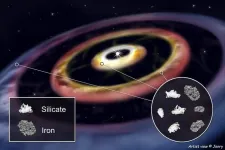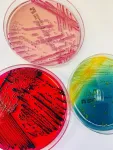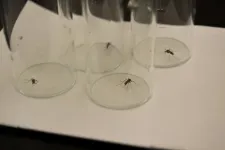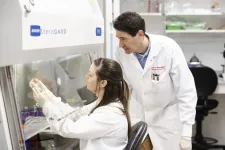(Press-News.org) The origin of Earth and the Solar System inspires scientists and the public alike. By studying the present state of our home planet and other objects in the Solar System, researchers have developed a detailed picture of the conditions when they evolved from a disk made of dust and gas surrounding the infant sun some 4.5 billion years ago.
Three rings hinting at two planets
With the breathtaking progress made in star and planet formation research aiming at far-away celestial objects, we can now investigate the conditions in environments around young stars and compare them to the ones derived for the early Solar System. Using the European Southern Observatory’s (ESO) Very Large Telescope Interferometer (VLTI), an international team of researchers led by József Varga from the Konkoly Observatory in Budapest, Hungary, did just that. They observed the planet-forming disk of the young star HD 144432, approximately 500 light-years away.
“When studying the dust distribution in the disk’s innermost region, we detected for the first time a complex structure in which dust piles up in three concentric rings in such an environment,” says Roy van Boekel. He is a scientist at the Max Planck Institute for Astronomy (MPIA) in Heidelberg, Germany and a co-author of the underlying research article to appear in the journal Astronomy & Astrophysics. “That region corresponds to the zone where the rocky planets formed in the Solar System“, van Boekel adds. Compared to the Solar System, the first ring around HD 144432 lies within Mercury’s orbit, and the second is close to Mars’s trajectory. Moreover, the third ring roughly corresponds to Jupiter’s orbit.
Up to now, astronomers have found such configurations predominantly on larger scales corresponding to the realms beyond where Saturn circles the Sun. Ring systems in the disks around young stars generally point to planets forming within the gaps as they accumulate dust and gas on their way. However, HD 144432 is the first example of such a complex ring system so close to its host star. It occurs in a zone rich in dust, the building block of rocky planets like Earth. Assuming the rings indicate the presence of two planets forming within the gaps, the astronomers estimated their masses to resemble roughly that of Jupiter.
Conditions may be similar to the early Solar System
The astronomers determined the dust composition across the disk up to a separation from the central star that corresponds to the distance of Jupiter from the Sun. What they found is very familiar to scientists studying Earth and the rocky planets in the Solar System: various silicates (metal-silicon-oxygen compounds) and other minerals present in Earth’s crust and mantle, and possibly metallic iron as is present in Mercury’s and Earth’s cores. If confirmed, this study would be the first to have discovered iron in a planet-forming disk.
“Astronomers have thus far explained the observations of dusty disks with a mixture of carbon and silicate dust, materials that we see almost everywhere in the Universe,” van Boekel explains. However, from a chemical perspective an iron and silicate mixture is more plausible for the hot, inner disk regions. And indeed, the chemical model that Varga, the main author of the underlying research article, applied to the data yields better-fitting results when introducing iron instead of carbon.
Furthermore, the dust observed in the HD 144432 disk can be as hot as 1800 Kelvin (approx. 1500 degrees Celsius) at the inner edge and as moderate as 300 Kelvin (approx. 25 degrees Celsius) farther out. Minerals and iron melt and recondense, often as crystals, in the hot regions near the star. In turn, carbon grains would not survive the heat and instead be present as carbon monoxide or carbon dioxide gas. However, carbon may still be a significant constituent of the solid particles in the cold outer disk, which the observations carried out for this study cannot trace.
Iron-rich and carbon-poor dust would also fit nicely with the conditions in the Solar System. Mercury and Earth are iron-rich planets, while the Earth contains relatively little carbon. “We think that the HD 144432 disk may be very similar to the early Solar System that provided lots of iron to the rocky planets we know today,” says van Boekel. ”Our study may pose as another example showing that the composition of our Solar System may be quite typical.”
Interferometry resolves tiny details
Retrieving the results was only possible with exceptionally high-resolution observations, as provided by the VLTI. By combining the four VLT 8.2-metre telescopes at ESO’s Paranal Observatory, they can resolve details as if astronomers would employ a telescope with a primary mirror of 200 metres in diameter. Varga, van Boekel and their collaborators obtained data using three instruments to achieve a broad wavelength coverage ranging from 1.6 to 13 micrometres, representing infrared light.
MPIA provided vital technological elements to two devices, GRAVITY and the Multi AperTure mid-Infrared SpectroScopic Experiment (MATISSE). One of MATISSE’s primary purposes is to investigate the rocky planet-forming zones of disks around young stars. “By looking at the inner regions of protoplanetary disks around stars, we aim to explore the origin of the various minerals contained in the disk – minerals that later will form the solid components of planets like the Earth,” says Thomas Henning, MPIA director and co-PI of the MATISSE instrument.
However, producing images with an interferometer like the ones we are used to obtaining from single telescopes is not straightforward and very time-consuming. A more efficient use of precious observing time to decipher the object structure is to compare the sparse data to models of potential target configurations. In the case of the HD 144432 disk, a three-ringed structure represents the data best.
How common are structured, iron-rich planet-forming disks?
Besides the Solar System, HD 144432 appears to provide another example of planets forming in an iron-rich environment. However, the astronomers will not stop there. “We still have a few promising candidates waiting for the VLTI to take a closer look at”, van Boekel points out. In earlier observations, the team discovered a number of disks around young stars that indicate configurations worth revisiting. However, they will reveal their detailed structure and chemistry using the latest VLTI instrumentation. Eventually, the astronomers may be able to clarify whether planets commonly form in iron-rich dusty disks close to their parent stars.
Background information
The MPIA researchers involved in this study are Roy van Boekel, Marten Scheuck, Thomas Henning, Jacob W. Isbell, Ágnes Kóspál (also HUN-REN Research Centre for Astronomy and Earth Sciences, Konkoly Observatory, Budapest, Hungary [Konkoly]; CSFK, MTA Centre of Excellence, Budapest, Hungary [CSFK]; ELTE Eötvös Loránd University, Budapest, Hungary [ELTE]), Alessio Caratti o Garatti (also INAF-Osservatorio Astronomico di Capodimonte, Naples, Italy).
Other contributors are: J. Varga (Konkoly; CSFK; Leiden Observatory, The Netherlands [Leiden]), L. B. F. M. Waters (Radboud University, Nijmegen, The Netherlands; SRON, Leiden, The Netherlands), M. Hogerheijde (Leiden; University of Amsterdam, The Netherlands [UVA]), A. Matter (Observatoire de la Côte d’Azur/CNRS, Nice, France [OCA]), B. Lopez (OCA), K. Perraut (Univ. Grenoble Alpes/CNRS/IPAG, France [IPAG]), L. Chen (Konkoly; CSFK), D. Nadella (Leiden), S. Wolf (University of Kiel, Germany [UK]), C. Dominik (UVA), P. Abraham (Konkoly; CSFK; ELTE), J.-C. Augereau (IPAG), P. Boley (OCA), G. Bourdarot (Max Planck Institute for Extraterrestrial Physics, Garching, Germany), F. Cruz-Saénz de Miera (Konkoly; CSFK; Université de Toulouse, France), W. C. Danchi (NASA Goddard Space Flight Center, Greenbelt, USA), V. Gámez Rosas (Leiden), K.-H. Hofmann (Max-Planck Institute for Radio Astronomy, Bonn, Germany [MPIfR]), M. Houllé (OCA), W. Jaffe (Leiden), T. Juhász (Konkoly; CSFK; ELTE), V. Kecskeméthy (ELTE), J. Kobus (UK), E. Kokoulina (University of Liège, Belgium; OCA), L. Labadie (University of Cologne, Germany), F. Lykou (Konkoly; CSFK), F. Millour (OCA), A. Moór (Konkoly; CSFK), N. Morujão (Universidade de Lisboa and Universidade do Porto, Portugal), E. Pantin (AIM, CEA/CNRS, Gif-sur-Yvette, France), D. Schertl (MPIfR), L. van Haastere (Leiden), G. Weigelt (MPIfR), J. Woillez (European Southern Observatory, Garching, Germany), P. Woitke (Space Research Institute, Austrian Academy of Sciences, Graz, Austria), MATISSE and GRAVITY Collaborations
END
Three iron rings in a planet-forming disk
A three-ringed structure in the planet-forming zone of a circumstellar disk where metals and minerals serve as a reservoir of planetary building blocks
2024-01-08
ELSE PRESS RELEASES FROM THIS DATE:
More than thirty new species of bacteria discovered in patient samples
2024-01-08
Unknown germs are a common occurrence in hospitals. Researchers at the University of Basel have spent many years collecting and analyzing them. They have identified many new species of bacteria, some of which are significant for clinical practice.
Bacterial infections can be treated more efficiently if the cause of the disease is known. In most cases, all it takes to identify a pathogen is an analysis in a medical laboratory. Sometimes, however, the standard methods are insufficient – for example, if the species of bacteria has not yet been classified or ...
Where do patients choose to undergo breast cancer surgery, and do these choices drive health care inequality?
2024-01-08
Including patients as partners for making decisions about their medical treatments is an important aspect of patient-centered care. A new study from England examined choices that patients with breast cancer make when considering where to have surgery for their condition and assessed how policies that offer such choices might affect inequalities in the health care system. The findings are published by Wiley online in CANCER, a peer-reviewed journal of the American Cancer Society.
For the study, investigators analyzed data from the National Health Service (NHS), the publicly ...
Some mosquitoes like it hot
2024-01-08
Certain populations of mosquitoes are more heat tolerant and better equipped to survive heat waves than others, according to new research from Washington University in St. Louis.
This is bad news in a world where vector-borne diseases are an increasingly global health concern. Most models that scientists use to estimate vector-borne disease risk currently assume that mosquito heat tolerances do not vary. As a result, these models may underestimate mosquitoes’ ability to spread diseases in a warming world.
Researchers led by Katie M. Westby, a senior scientist at Tyson Research Center, Washington ...
Out-of-pocket cost increase could put HIV prevention medications out of reach
2024-01-08
PHILADELPHIA – Increasing patients’ out of pocket costs for HIV pre-exposure prophylaxis (PrEP), medications, which have been shown to dramatically reduce the risk of HIV infection, could lead to a significant reduction in PrEP use and a rise in HIV infection rates, according to a new study co-led by researchers at the Perelman School of Medicine at the University of Pennsylvania and Johns Hopkins Bloomberg School of Public Health.
The study, published today in Health Affairs, was designed, in part, to explore the impact that out-of-pocket cost increases could have, depending on the outcome of an ongoing court case challenging certain ...
Survey finds majority of Americans think bariatric surgery is a shortcut to losing pounds, should only be a last resort
2024-01-08
Orlando, Fla - More than two in five U.S. adults suffer from obesity, an epidemic that continues to trend upward. While bariatric surgery is an extremely effective treatment option, a new national survey by Orlando Health reveals common stigmas that may deter those who qualify for surgery from pursuing the treatment they need.
“Treatment plans for obesity are tailored to each individual patient based on things like body mass index and existing medical conditions and may include medication, lifestyle changes, counseling and bariatric surgery,” said Andre Teixeira, MD, medical ...
First ever scientific study on First World War crater reveals new details on its history
2024-01-08
The spectacular explosion of the mine at Hawthorn Ridge – a fortified German front-line position in the First World War – marked the beginning of the Battle of the Somme, and remains one of the best-known pieces of film from the whole conflict.
More than 60ft below the surface, British miners had dug a gallery for more than 900 metres from their lines and packed it with 40,000 lbs of explosives. It was one of 19 mines placed beneath German front positions that were detonated on 1st July, 1916 to mark the start of the offensive.
But the detonation of the ...
Blood flow changes in the eyes could influence visual symptoms of migraines
2024-01-06
A recent study found changes in blood flow in the retina could explain why some migraine patients experience visual symptoms. The findings could represent a long-sought observable marker for migraines that doctors can use to aid in the clinical treatment of the condition.
While patients with migraines often experience symptoms such as pain around the eye, sensitivity to light, blind spots and visual blurring, the mechanisms behind those symptoms have not been well understood. UCLA Health researchers used a non-invasive imaging technique, known as optical coherence tomography angiography, or OCTA, ...
Global scientific network highlights plant genera named for women
2024-01-06
A network of scientists across the globe have identified more than 700 plant genera named for women. This is a nearly twenty-fold increase in the number of genera linked to women before the group started working on the list.
The project, which aimed to highlight the contribution of women to botany, was the result of social media conversations about plants named for people.
What began as a simple question about how many and which plant genera were named for women evolved into a global network of scientists who built ...
UofL researchers are unmasking an old foe’s tricks to thwart new diseases
2024-01-05
When the body encounters bacteria, viruses or harmful substances, its innate immune cells, neutrophils, assemble at the site to combat the invader.
Bacteria and viruses have ways to avoid these defenses, however. Yersinia pestis, the bacteria that causes bubonic and pneumonic plague, for example, can hide from the immune system, allowing it to replicate in the body unhindered until it can overwhelm the host. This ability allowed Y. pestis to spread bubonic plague across Europe in the 14th Century, killing a third of the European population.
While plague may not be a serious threat to human health in modern times, researchers at the University of Louisville are studying Y. ...
Soil fungi may help explain the global gradient in forest diversity
2024-01-05
A paper published in Nature Communications Biology contributes to the growing appreciation for the outsize role that microbes play in everything from human digestion to crop yields: Microbes in the soil—fungi in this case—appear to be influencing forest diversity on a global scale.
Forests on Earth exhibit a marked gradient from the equator toward the poles: Tropical forests near the equator tend to include a large number of different species, whereas forests nearer the poles support less plant diversity.
One explanation for this phenomenon maintains that soil pathogens, including bacteria and fungi, help create this gradient. ...
LAST 30 PRESS RELEASES:
Mercury exposure in northern communities linked to eating waterfowl
New Zealand researchers identify brain link to high blood pressure
New research confirms people with ME/CFS have a consistent faulty cellular structure
Hidden cancer risk behind fatty liver disease targets
Born in brightness, leading to darkness
Boron-containing Z-type and bilayer benzoxene
Hong Kong researchers break the single-field barrier with dual-field assisted diamond cutting
Work hard, play hard?
Wood becomes smart glass: Photo- and electro-chromic membrane switches tint in seconds
The Lancet: COVID-19 vaccine hesitancy decreased over time, though mistrust persists among certain groups, study of over 1 million people in England suggests
Psychosis patients ‘living in metaphor’ -- new study radically shifts ideas about delusions
Clinical trial in Ethiopia targets the trachoma scourge
Open-sourcing the future of food
Changes in genetic structure of yeast lead to disease-causing genomic instabilities
UC San Diego Health Sciences Grant Writing Course helps launch successful research careers
Study: Many head and neck cancer trials end early. Why?
Tufts vice provost for research named Foreign Fellow of Indian National Science Academy
New model improves prediction of prostate cancer death risk
Two wrongs make a right: how two damaging variants can restore health
Overlooked decline in grazing livestock brings risks and opportunities
Using rare sugars to address alcoholism
Research alert: New vulnerability identified in aggressive breast cancer
Ruth Harris honored with SSA Distinguished Service Award
Treasure trove of data on aging publicly accessible
Trees4Adapt project to address risks from climate change and biodiversity loss through tree-based solutions
Nature Communications study from the Lundquist Institute identifies molecular mechanism underlying peripartum cardiomyopathy
Pennington Biomedical’s Dr. Gang Hu appointed to NIH Reproductive, Perinatal and Pediatric Health Review Group
World-first project shows great promise to treat low eye pressure
New technique puts rendered fabric in the best light
Brain cancer digital twin predicts treatment outcomes
[Press-News.org] Three iron rings in a planet-forming diskA three-ringed structure in the planet-forming zone of a circumstellar disk where metals and minerals serve as a reservoir of planetary building blocks





